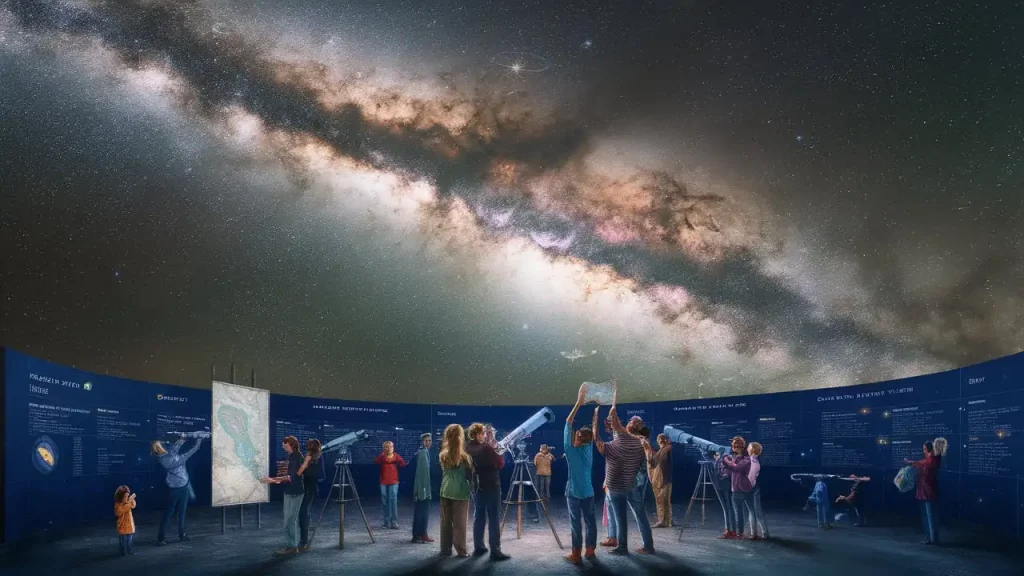Observing the Milky Way in 2024 is a celestial delight that combines ancient myths with modern technology. Understanding the best directions, utilizing helpful apps, and knowing the precise position of the Milky Way today can significantly enhance your stargazing experience. The 天の川 2024 方角 is especially significant during Tanabata, and this article will guide you on how to observe it effectively.
Introduction to the Milky Way
The Milky Way, known in Japanese as “天の川” (Amanogawa), is a stunning astronomical phenomenon composed of countless stars. This celestial band of light is part of our galaxy, the 天の川 2024 方角 Galaxy, which houses approximately 200 billion stars, including our solar system. From Earth, our position within the galaxy allows us to perceive it as a luminous river of stars stretching across the night sky.

Historical Background: The 天の川 2024 方角 in Myth and Discovery
The Legend of Tanabata
In Japanese culture, the Milky Way plays a central role in the Tanabata festival. This festival commemorates the legendary meeting of Orihime (the star Vega) and Hikoboshi (the star Altair), lovers separated by the Milky Way who are allowed to reunite once a year on the seventh day of the seventh month.
Read More: The Rock’s Net Worth in 2024: Has His Salary Increased to $800 Million
Galileo’s Contribution
The realization that the Milky Way is a collection of stars was made by Galileo Galilei, who first directed his telescope towards it in the early 17th century. His observations revealed that the 天の川 2024 light comes from a multitude of individual stars, transforming our understanding of this celestial feature.
Why is it Called the “天の川 2024 方角”?
The term “Milky Way” has its origins in Greek mythology. According to legend, the Milky Way was created from the spilled milk of Hera, the wife of Zeus, when the infant Hercules suckled her too strongly. This mythological imagery influenced the name “Milky Way,” emphasizing the galaxy’s milk-like appearance.
Best Times and Conditions for Viewing the 天の川 2024 方角
Year-Round Visibility
While many believe the Milky Way is only visible during certain times, it is actually visible throughout the year. However, the summer months provide the most spectacular views. During summer nights in the Northern Hemisphere, Earth faces the galaxy’s densely populated center, making the Milky Way appear brighter and more prominent.
Optimal Viewing Months
The best time to observe the Milky Way is in late summer. In 2024, the traditional Tanabata festival, based on the lunar calendar, falls on August 10th. Observations around this date, especially from mid to late August, offer ideal conditions for viewing the Milky Way.
Ideal Locations and Conditions for Observation
Geographic and Atmospheric Considerations
To observe the Milky Way at its best, choose locations far from city lights and with clear, open skies. Avoid areas with high atmospheric humidity, such as coastal regions or places with recent rainfall, as water vapor can obscure star visibility.
Specific Viewing Times
The Milky Way is most visible between 8 PM and 10 PM. During this time, it rises from the eastern horizon and moves southward, providing ample opportunity for observation.
Navigating the Night Sky: Finding the Milky Way
The Summer Triangle
Begin by locating the Summer Triangle, composed of three bright stars: Vega in Lyra, Altair in Aquila, and Deneb in Cygnus. This triangle serves as a reliable guide, with the Milky Way flowing through its center.
Key Constellations and Stars
- Vega (Orihime) in Lyra
- Altair (Hikoboshi) in Aquila
- Deneb in Cygnus
Tracing the Milky Way southward from the Summer Triangle, you’ll encounter Antares, a bright red star in Scorpius. Continuing eastward from Antares, look for the distinctive “Teapot” asterism in Sagittarius, which marks the galaxy’s densest and brightest region.
Practical Tips for Successful Observation
Selecting the Best Spots
- Dark Sky Locations: Seek out rural areas or designated dark sky parks.
- High Altitude: Higher elevations reduce atmospheric interference.
- Weather Conditions: Choose nights with clear skies and minimal humidity.
Equipment Recommendations
- Binoculars: Enhance your view without the complexity of a telescope.
- Telescope: For detailed observations of specific stars and celestial features.
- Star Charts and Apps: Utilize tools to assist in identifying constellations and navigating the night sky.
Using Apps to Locate the Milky Way
In today’s digital age, several apps can aid in locating the Milky Way 2024, ensuring you have the best chance of viewing it. These apps provide real-time data on the Milky Way 2024’s position today and optimal viewing directions.
Recommended Apps
- Star Walk 2: Offers detailed star maps and real-time Milky Way positions.
- SkyView: An augmented reality app that helps you find the Milky Way 2024 and other celestial objects.
- Stellarium: Provides comprehensive star charts and detailed information on celestial events.
Using these apps, you can pinpoint the Milky Way 2024 position today and determine the best viewing angles, ensuring a successful stargazing experience.
Conclusion
Observing the Milky Way is a mesmerizing experience that connects us with the vast cosmos. By understanding the optimal times, directions, and conditions, we can enhance our stargazing adventures. We hope these insights inspire you to seek out the Milky Way 2024 and appreciate the beauty of our galaxy.

